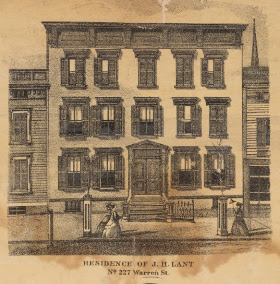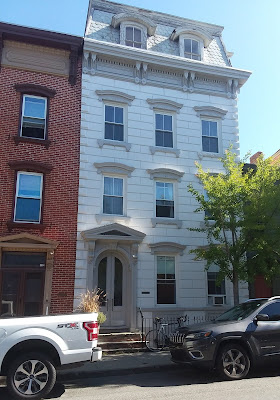Notable about this particular map are the nineteen images of significant buildings in the city that decorate the perimeter. To celebrate the campaign for its restoration achieving its goal, Gossips reviews and identifies those buildings--some survive, and some are gone.
***********
The residence of Cornelius H. Evans, absent its little corner veranda, is still stands at 412 Warren Street.
************
The publisher of the map, J. H. Lant, included an image of his own house, which in 1871 stood at 227 Warren Street. When the numbering of buildings changed in 1888-1889, with the introduction of 100 blocks, the address became 427 Warren Street. The building that was Lant's home was destroyed by fire in 1951, and in its place was constructed the building that was until recently the headquarters of the Hudson Police Department. |
| PhotobyGibson.com |
************
What was City Hall in 1871 is now Hudson Hall at the Historic Hudson Opera House.
************
************
Hudson Academy was founded in 1805. The school building stood at the summit of what is known as Academy Hill. After Hudson Academy closed in 1886, the building was used from 1889 to 1894 for the newly created Hudson High School, Hudson's first public secondary school. |
| Photo courtesy Historic Hudson |
************
This building is identified as the residence of F. F. Folger. Today, we know it as Cavell House, the location of New York Oncology and Hematology.
The house is believed to have been built around 1819 for Obed Worth Folger, Frederick Fitch Folger's father. Frederick, who was born in 1812, would have spent much of his childhood in the house. In 1853, having acquired a "satisfactory fortune" in New Orleans, Frederick returned to Hudson and purchased the "Bronson Place," which he named "Glenwood." He continued to be involved with his brother Nathan's business in New Orleans, the nature of which Gossips has explored elsewhere. According to Frederick's biography in Columbia County at the End of the Century, the Civil War "nearly wrecked" his brother's business, and he went back to New Orleans to tend to his financial interests. He sold Glenwood to Mary Whitney Phoenix in 1864, and when he returned to Hudson in 1869, he took up residence in what had been his father's house. (The Hudson city directory for 1870 lists Mrs. Mary Folger, Obed's wife and Frederick's mother, living on Warren Street at the corner of Prospect Avenue.)
In 1918, Dr. and Mrs. John C. Smock, then the owners of the house, donated it to Hudson Hospital for convalescent soldiers and sailors returning from Europe after World War I. Later it housed the hospital's nursing school and was named Cavell House for Edith Cavell, the British nurse who helped hundreds of British, French, and Belgian soldiers escape the Germans during the first year of the Great War and was arrested, tried, and executed in 1915.
************
The city directory for 1870 gives the address of Harper W. Rogers' home as simply "Green Street." It is possible to think that the house depicted on the 1871 map, enhanced with the addition of porches, dormers, a circle bay ending in the turret, and decorative brackets, is the same house that in 1905 was the home of Harper's youngest son, Charles S. Rogers. C. S. Rogers' house was located at 24 Green Street. Sadly, it no longer exists.
************
The residence of George H. Power is 400 State Street. Originally built in 1818 as the Hudson almshouse, the building had been a lunatic asylum and a female seminary before it became Power's private residence, and it was an orphanage and then the public library after his residency. The building is now owned by the Galvan Foundation.
************
The residence of Allen Rossman, seen in the image from the map and the photographs below, no longer exists, but Rossman Avenue, a collection of turn-of-the-century and early 20th-century houses, bears his name.
************
The residence of Silas W. Toby, where one of Gossips' idols, Anna Bradbury, once lived as a boarder, was located at 729 Warren Street. It is believed that the house may survive beneath the Diamond building, which now occupies the site.
***********
This, of course, is the first Columbia County court house to occupy the site at the south end of the Fourth Street transept, built in 1835.
 |
| Photo courtesy Historic Hudson |
************
George Parton was the father of Hudson River School painters Arthur and Ernest Parton. According to the Hudson city directory for 1870, George Parton lived on Prospect Avenue, but exactly where this house was located is not known.
************
The residence of Ezra Waterbury, notable for being a rare example of a cast-iron facade on a domestic building, still stands at 124 Warren Street.
*********
In 1907, after the National Hudson River Bank had moved to its new building at 520 Warren Street, now City Hall, the Elks Club took over this building at 231 Warren Street. The building suffered a damaging fire in the summer of 1935, and soon after that, the Elks having departed to 601 Union Street, the building was demolished.
************
This building, which was constructed in 1805, was damaged by fire in 1919. When the building was repaired after the fire, the roof line was altered, but the building still stands at 364 Warren Street.
************
An image of the residence of J. H. Lant, who published the map, is included on the map, and so is the residence of Alex. S. Rowley, who drew the map. This charming Gothic Revival cottage, once the home of Cassandra Danz, a.k.a. Mrs. Greenthumbs, still stands at 611 Union Street.
************
The residence of Augustus and Ellen McKinstry stood at 886 Columbia Street. The house, which is also shown in the photograph below, was demolished in 1910 to make way for the Dinehart mansion.
************
The residence of Casper P. Collier stood at 363 Allen Street, where there is now a parking lot for the court house. The house, then owned by Columbia County, was demolished sometime in the late 1970s or early 1980s. In the 1930s, it was photographed by Walker Evans.
 |
| Walker Evans Archive|Metropolitan Museum of Art |
************
The store and residence of H. C. Turner may be the most interesting of the buildings included on the map, because H. C. Turner was Miss H. C. Turner, and her store was a millinery shop. The map gives the address as 279 Warren Street which, according to the Hudson Tap Book, became 521 Warren Street after the renumbering in 1888-1889. The building is remarkably altered today, with greater height and different fenestration. The first photograph below provides evidence that some of the changes--the addition of another floor--occurred prior to 1905, when the building was the location of K. V. Clark, "Hudson's Leading Cloak and Suit House." It is not known when the changes in the second floor fenestration and the alteration of the storefront happened.
************
We in Hudson take pride, justifiably, in our architectural heritage, but it is sobering to realize that, of the nineteen buildings considered significant enough to be portrayed on a map of the city in 1871, only eight of them survived through the 20th century.
Update: At approximately 6:30 a.m. on Monday morning, the GoFundMe campaign for the restoration of the map reached its goal of $7,500!
Update: At approximately 6:30 a.m. on Monday morning, the GoFundMe campaign for the restoration of the map reached its goal of $7,500!
COPYRIGHT 2019 CAROLE OSTERINK







































Thank you Carole for this amazing and informative posting,as always!
ReplyDeleteCarole, I cannot thank you enough for this post and for helping our gofundme campaign reach our generous donors! We, at the library, felt this map was valuable for many reasons and your post certainly illustrates that. In addition to this map being a somewhat rare item, we also felt that the line drawings held a lot of potential for historic interest. Thank you for all your work researching the buildings in the line drawings. Just amazing!
ReplyDeleteWe lose these houses because shortsighted planning boards, such as the one we have right now, allow it to happen.
ReplyDeleteThe original, unaltered Harper W. Rogers house is visible in Hubbel's 1890 photo from Academy Hill. The house stood at the location of today's One Hudson City Centre, which appears to cover over 24 Green Street. That's the same address as Rogers' son who almost certainly altered his father's house.
ReplyDeleteAmazing post, amazing history, thank you for the documentation.
ReplyDelete